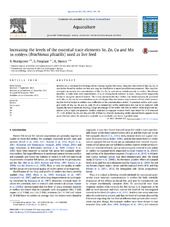| dc.contributor.author | Nordgreen, Andreas Hoel | eng |
| dc.contributor.author | Penglase, Samuel | eng |
| dc.contributor.author | Hamre, Kristin | eng |
| dc.date.accessioned | 2015-04-13T12:11:21Z | |
| dc.date.available | 2015-04-13T12:11:21Z | |
| dc.date.issued | 2013-03-04 | eng |
| dc.identifier.issn | 0044-8486 | en_US |
| dc.identifier.uri | http://hdl.handle.net/1956/9773 | |
| dc.description.abstract | Rotifers are a common first feeding diet for rearing marine fish larvae. However, the levels of Mn, Cu, Zn, Se and iodine found in rotifers are low and may be insufficient to meet larval fish requirements. This study investigates increasing the concentration of Mn, Cu, Zn, Se and iodine simultaneously in rotifers (Brachionus plicatilis) in both short term enrichments (3 h) or during batch cultures (6 days), using either organically bound or inorganic mineral sources. This study demonstrates that rotifers can simultaneously be produced with Mn, Cu, Zn and Se concentrations up to and higher than the known requirements of fish, while increasing the level of iodine in rotifers was ineffective at the concentrations tested. To produce rotifers with copepod levels of Mn, Cu, Zn and Se, only 6% of a commercial rotifer enrichment diet had to be replaced with organically bound minerals, leaving a large percentage of the rotifer diet free to deliver other important nutrients such as lipid and proteins. Rotifers enriched to copepod mineral levels and stored for 18 h retained 75–110% of their Se, Zn and Mn and 50% of their Cu. Overall, increasing rotifer mineral levels appears to be most effective when the mineral is available in an insoluble and hence ingestible form. | en_US |
| dc.language.iso | eng | eng |
| dc.publisher | Elsevier | en_US |
| dc.rights | Attribution-NonCommercial-NoDerivs CC BY-NC-ND | eng |
| dc.rights.uri | http://creativecommons.org/licenses/by-nc-nd/3.0/ | eng |
| dc.subject | Rotifers | eng |
| dc.subject | Enrichment | eng |
| dc.subject | Mn | eng |
| dc.subject | Cu | eng |
| dc.subject | Zn | eng |
| dc.subject | Se | eng |
| dc.title | Increasing the levels of the essential trace elements Se, Zn, Cu and Mn in rotifers (Brachionus plicatilis) used as live feed | en_US |
| dc.type | Peer reviewed | |
| dc.type | Journal article | |
| dc.date.updated | 2015-04-01T08:46:24Z | en_US |
| dc.description.version | publishedVersion | en_US |
| dc.rights.holder | Copyright 2012 Elsevier B.V. | en_US |
| dc.identifier.doi | https://doi.org/10.1016/j.aquaculture.2012.11.032 | |
| dc.identifier.cristin | 1028512 | |
| dc.source.journal | Aquaculture | |
| dc.source.40 | 380 | |
| dc.source.pagenumber | 120-129 | |
| dc.relation.project | Norges forskningsråd: 199482 | |
| dc.relation.project | EU: LARVANET – COST action FA0801 | |
| dc.subject.nsi | VDP::Technology: 500::Food science and technology: 600 | en_US |
| dc.subject.nsi | VDP::Teknologi: 500::Næringsmiddelteknologi: 600 | nob |

